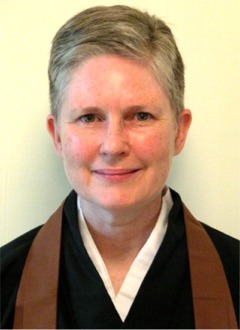 The Sangha Jewel Lecture by Josho Pat Phelan |
Three Refuges are Buddha, Dharma and
Sangha. The Refuges are also called the Three Jewels and the Three
Treasures because they are considered precious to Buddhist practice. It
may be easier to see the importance or necessity of Buddha, or the
awakened quality of consciousness, and Dharma, or Buddha’s teaching and
practice of how to wake up, than it is to see the necessity of Sangha.
Originally sangha meant Buddha’s disciples, the monks and nuns who practiced with him. Later in India, it came to mean any community of Buddhist monks or nuns. Today we use sangha to mean a group of people practicing together. Can you imagine practicing without each other, without the zendo, without the programs, without the teachers who visit? Without a sangha, we would just stay at home and sit by ourselves. I used to watch a yoga teacher on television and tried to do yoga, without getting any feedback or individual instruction, and I didn’t stick with it. Imagine watching service at home, and bowing in front of the TV and chanting along. It would be much different practice. The sangha is an enormous support for practice. In Buddhism there are ten Major Precepts, forty-eight Minor Precepts and sometimes 250 to 350 ways of right conduct that are used in monastic practice. One of the functions of the precepts is to protect the Sangha, and in turn protect the opportunity for people to practice. There are also five major offenses for which someone can be expelled from the Sangha, including killing a parent, drawing blood from a Buddha or Arhat, as well as causing diviseness or disharmony in the Sangha. I think the main way divisiveness is caused is through speech by talking about someone to somebody else, by slandering, backbiting, putting others down, and harsh speech. Talking about others poisons sangha relations. Doing this is not helpful to one’s own heart and mind of practice, to the person being talked about, or to the sangha as a whole. We can hold this question as a koan, as a way to understand our human nature, and as a way to understand the precepts, "Why do I talk about other people?" "What do I get out of it?" |
|
Sometimes we do it because it makes
us feel better, better than someone else, or it helps us feel that we
are right and the people who annoy us are wrong. We talk to our friends
about this annoying person in order to get support for our view, so we
can feel justified in feeling annoyed or whatever it is we
feel. This, in turn, strengthens our view and makes it seem more fixed
and more solid, so that we have even more of an investment in defending
our view. We feed it and nourish it with more talk about the other
person. This activity is based on insecurity. And instead of using
practice to work with our weak areas, we instead help solidify and
justify our insecurities.
The zendo, of course, isn’t some kind of club or sorority where you need to apply to and be accepted before you can practice here. The zendo is open to whoever wants to do this practice; and we practice with whoever comes, not just the people we like or who are like us. This is practice based on vow rather than on preferences. When we come to the zendo, we try to embody something deeper, something more fundamental, than our preferences. Also, in Zen the meaning of sangha isn’t limited to the people we practice with. In addition to the practitioners here, our sangha includes all people, all beings and all things. Katagiri Roshi said, "...in the Buddhist Sangha, we have to practice not for ourselves but for others first.... ‘For others’ means not only for human beings but for all living beings, for a piece of toilet paper, our clothes, our cushions, vegetables, pans, for everything. Help all living beings. This does not mean to give them something material or psychological. Giving lots of material things to others isn’t necessarily helpful. To help all living beings means to deal with them wholeheartedly whenever we encounter them, with compassionate, kind attention. This is the way to help others and all things around our lives, vegetables, books, tables, floors, lights, water – all things, visible or invisible." Can you imagine treating a hand made tea cup, or a Buddha statue, or a glass vase that belonged to your great-grandmother with care and attention and love? In a way, it may seem easier to be kind to our pets and the things that we cherish than it is to other people. But practice is to extend this same kind of wholehearted attention to people, not just to people we like, but to whomever we meet. The practice of sangha may be the hardest of the Three Jewels to polish, and so our vow becomes endless. © Copyright Josho Pat Phelan, 2015 |
|
